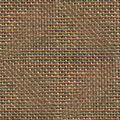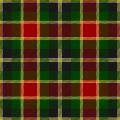Sateen
This article needs additional citations for verification. (May 2015) |

Sateen is a fabric made using a satin weave structure, but made with spun yarns instead of filament.[1]
The sheen and softer feel of sateen is produced through the satin weave structure. Warp yarns are floated over weft yarns, for example four over and one under (for a five-harness satin weave). In a weft-faced satin or sateen, the weft yarns are floated over the warp yarns. Standard tabby weaves use a one-over, one-under structure.
The long floats of satin and sateen produce a surface that is smooth to the touch and reduces light scattering to increase shine. This weave structure is more susceptible to wear than other weaves; the long floats tend to catch. It is, however, flexible and drapes well, so it is often used for woven-cloth composites.
In modern times cheaper rayon is often substituted for cotton. Better qualities are mercerized to give a higher sheen. Some are only calendered to produce the sheen, but this disappears with washing.
See also[]
References[]
- ^ Tortora, Phyllis G. (2005) Fairchild's Dictionary of Textiles (7th Ed.) New York: Fairchild Publications, p. 490. ISBN 9780870057076.
- Woven fabrics
- Textile stubs


